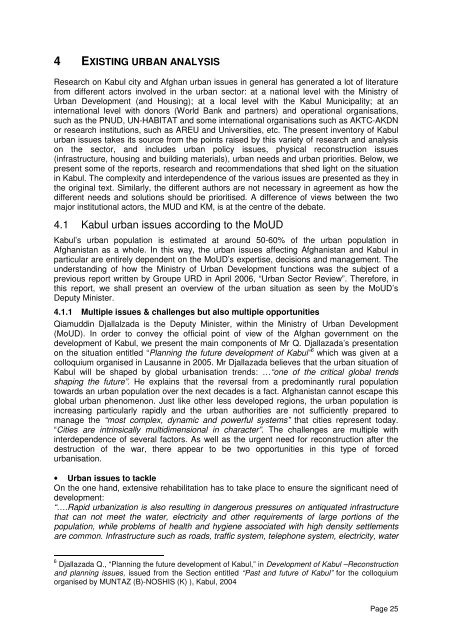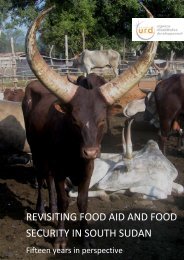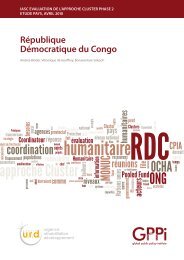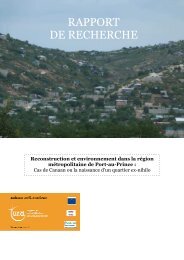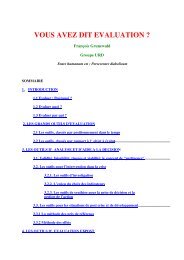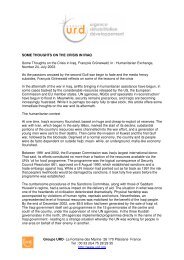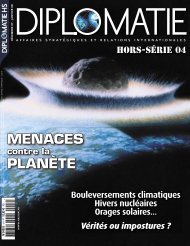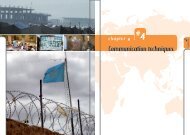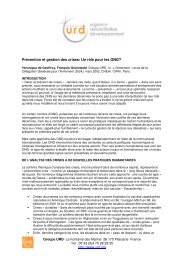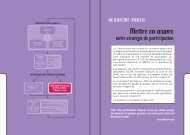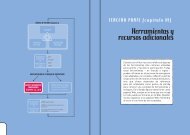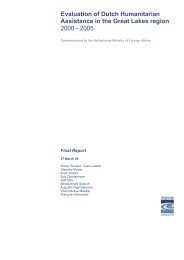Kabul Urban Survey - Groupe URD
Kabul Urban Survey - Groupe URD
Kabul Urban Survey - Groupe URD
Create successful ePaper yourself
Turn your PDF publications into a flip-book with our unique Google optimized e-Paper software.
4 EXISTING URBAN ANALYSIS<br />
Research on <strong>Kabul</strong> city and Afghan urban issues in general has generated a lot of literature<br />
from different actors involved in the urban sector: at a national level with the Ministry of<br />
<strong>Urban</strong> Development (and Housing); at a local level with the <strong>Kabul</strong> Municipality; at an<br />
international level with donors (World Bank and partners) and operational organisations,<br />
such as the PNUD, UN-HABITAT and some international organisations such as AKTC-AKDN<br />
or research institutions, such as AREU and Universities, etc. The present inventory of <strong>Kabul</strong><br />
urban issues takes its source from the points raised by this variety of research and analysis<br />
on the sector, and includes urban policy issues, physical reconstruction issues<br />
(infrastructure, housing and building materials), urban needs and urban priorities. Below, we<br />
present some of the reports, research and recommendations that shed light on the situation<br />
in <strong>Kabul</strong>. The complexity and interdependence of the various issues are presented as they in<br />
the original text. Similarly, the different authors are not necessary in agreement as how the<br />
different needs and solutions should be prioritised. A difference of views between the two<br />
major institutional actors, the MUD and KM, is at the centre of the debate.<br />
4.1 <strong>Kabul</strong> urban issues according to the MoUD<br />
<strong>Kabul</strong>’s urban population is estimated at around 50-60% of the urban population in<br />
Afghanistan as a whole. In this way, the urban issues affecting Afghanistan and <strong>Kabul</strong> in<br />
particular are entirely dependent on the MoUD’s expertise, decisions and management. The<br />
understanding of how the Ministry of <strong>Urban</strong> Development functions was the subject of a<br />
previous report written by <strong>Groupe</strong> <strong>URD</strong> in April 2006, “<strong>Urban</strong> Sector Review”. Therefore, in<br />
this report, we shall present an overview of the urban situation as seen by the MoUD’s<br />
Deputy Minister.<br />
4.1.1 Multiple issues & challenges but also multiple opportunities<br />
Qiamuddin Djallalzada is the Deputy Minister, within the Ministry of <strong>Urban</strong> Development<br />
(MoUD). In order to convey the official point of view of the Afghan government on the<br />
development of <strong>Kabul</strong>, we present the main components of Mr Q. Djallazada’s presentation<br />
on the situation entitled “Planning the future development of <strong>Kabul</strong>” 6 which was given at a<br />
colloquium organised in Lausanne in 2005. Mr Djallazada believes that the urban situation of<br />
<strong>Kabul</strong> will be shaped by global urbanisation trends: …“one of the critical global trends<br />
shaping the future”. He explains that the reversal from a predominantly rural population<br />
towards an urban population over the next decades is a fact. Afghanistan cannot escape this<br />
global urban phenomenon. Just like other less developed regions, the urban population is<br />
increasing particularly rapidly and the urban authorities are not sufficiently prepared to<br />
manage the “most complex, dynamic and powerful systems” that cities represent today.<br />
“Cities are intrinsically multidimensional in character”. The challenges are multiple with<br />
interdependence of several factors. As well as the urgent need for reconstruction after the<br />
destruction of the war, there appear to be two opportunities in this type of forced<br />
urbanisation.<br />
• <strong>Urban</strong> issues to tackle<br />
On the one hand, extensive rehabilitation has to take place to ensure the significant need of<br />
development:<br />
“….Rapid urbanization is also resulting in dangerous pressures on antiquated infrastructure<br />
that can not meet the water, electricity and other requirements of large portions of the<br />
population, while problems of health and hygiene associated with high density settlements<br />
are common. Infrastructure such as roads, traffic system, telephone system, electricity, water<br />
6 Djallazada Q., “Planning the future development of <strong>Kabul</strong>,” in Development of <strong>Kabul</strong> –Reconstruction<br />
and planning issues, issued from the Section entitled “Past and future of <strong>Kabul</strong>” for the colloquium<br />
organised by MUNTAZ (B)-NOSHIS (K) ), <strong>Kabul</strong>, 2004<br />
Page 25


